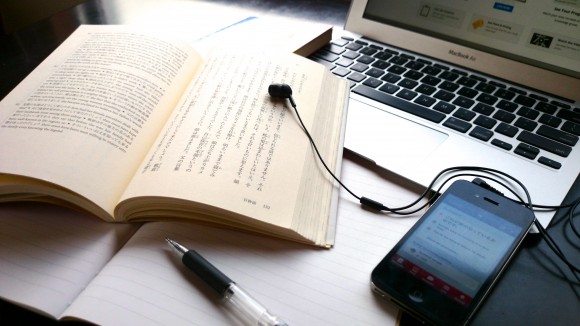
As we’ve said before, Japanese isn’t actually as hard to learn as it’s often made out to be. Unlike English, for example, Japanese follows its own grammatical rules far more rigidly, pronunciation is easy because there is only one variant of each vowel sound to choose from (none of this tomayto/tomahto business), and it’s possible to create entire, perfectly meaningful and valid sentences without uttering a single pronoun or bothering to conjugate a verb.
Nevertheless, the language will not magically seep into you through a desire to speak it alone — you still need to encounter and study it as often as possible. With that in mind, we’d like to present to you the six and a half resources that no dedicated student of the Japanese language should ever be without. Oh, and the good news is some of them are completely free.
1. “Imiwa?”
Your dictionary is the tool you’ll use most often while learning any foreign language, so you need to pick a good one. As much as we love paperbacks and hard copies of books, short of finding a six-inch-thick Japanese/English dictionary that also comes with a team of thumb-sized elves who flick to the right entry on command and then keep a record of it for easy access, paper dictionaries just aren’t going to cut it any more. But why spend hundreds of dollars on a dedicated electronic dictionary when you can get one that lives inside your smartphone, is constantly updating itself to become more useful, and costs absolutely nothing?
Formerly known as Kotoba!, iOS application Imiwa? is arguably one of the best dictionaries out there. Available for iPhone, iPod touch, and iPad, Imiwa? is completely ad-free and, as well as being created and maintained by a genuinely dedicated and experienced team, has won legions of fans across the globe — and for good reason. At time of writing, the app is up to version 4.0 and includes pretty much everything you could ever need from a dictionary, including word lookups, kanji searches (searchable by radical, stroke order or words in which they appear), synthesised speech, verb conjugation, customisable lists, an enormous number of example sentences with words shown in context, and more. It’s also multilingual, supporting English, French, Spanish, German, Italian, Korean, Portuguese, and Russian.
Even if you’re a dedicated Android user or recently made the switch to Google’s OS, there must be an old iPhone lying around your or a friend’s house, so do yourself a favour, grab it and install Imiwa? today. (But if you’re determined not to be seen in public with an iOS device then JED, while not quite as expansive or aesthetically pleasing as Imiwa?, is a solid Japanese/English dictionary app for Android, and also completely free.)
Check it out on iTunes or Facebook now. You won’t regret it.
2. Rikaichan
As far as Japanese learners are concerned, Rikaichan is easily the “best plug-in ever”. With a single click, Firefox users activate a plug-in that allows them to browse Japanese websites with instant, no-fuss access to an extensive Japanese/English dictionary. Just hover your cursor over the word you’re struggling to understand and the plug-in will throw up not just a reading, but its meaning, and in some cases even break multiple-kanji words down for you so you can see what the individual characters mean.
Rikaichan is a reliable, easy-to-use, and completely free tool that makes navigating Japanese content online far less painful, and once you discover it you’ll never want to let it go. Oh, and Chrome users need not despair either – Rikaikun, a solid port of the Rikaichan application, is available for Google’s browser over at the Chrome web store.
3. A decent reference book
Focusing on grammar is a bad way to learn a language (how many three-year-olds do you know who study verb conjugation when picking up their mother tongue?), but there are times when you’ll need to know how to properly conjugate a verb, remind yourself of the usage of a set phrase, or check the meaning of an idiom. At which point, you’ll need something to refer to. Books like (there are plenty of others out there!) Naoko Chino’s Japanese Verbs at a Glance fill that role perfectly.
Not a textbook per-se, Japanese Verbs at a Glance is a reference that is intended to be consulted right the way through one’s studies. Chino’s book covers pretty much every situation you’ll encounter in daily conversation, from asking favours of someone to reporting speech that you’ve heard someone else utter, and prints sentences in their natural kanji/kana combinations (with Romanised readings) for easy understanding. You’ll also find pages of charts with verbs in every possible form, and a comprehensive index at the back of the book for quick look-up. Of course, there are a lot of similar books out there, but having used this one for years, we can safely say that Naoko Chino’s pocket-sized guide has helped us out of a many a jam and, however much we improve, will remain on the shelf for future reference.
4. Read the Kanji
Kanji study is rarely fun, but this website almost makes a game out of it, and is not just effective but surprisingly addictive. After selecting your level (you can opt to study only kanji that appear in each JLPT level, or study hiragana, katakana or even yojijukugo four-kanji phrases popular in Japanese culture), the site presents you with a sentences containing target kanji characters as they might naturally appear in real-world phrases. It’s your job to type in the correct reading for the word, which the site will automatically convert into hiragana. Then, hit the ‘enter’ key and you’ll see either a green circle or a red X flash up for a split second indicating a right or wrong answer, respectively, before the next sentence appears. It’s as simple as that.
Part of the reason Read the Kanji works so well is because of the way the site learns from your mistakes and drills you with kanji and vocabulary that you seem to struggle with. If you correctly identify some low-level character on your first try, for example, it knows that you don’t need to drill it so often, so will only occasionally throw it your way. Make a mistake, however, and it’ll push that kanji forward a little more often.
Things get addictive, though, when you start noticing the colour each character appears at the top of the screen. Each time you correctly identify a word, you’ll notice that it will slowly start to go from dark red through orange and yellow to dark green, with the last colour indicating total proficiency. It’s rare to get that “just one more try” feeling during study, but Read the Kanji manages to evoke it, and it’s surprising how addictive the mere act of making a row of kanji tiles change the same colour can be.
The only possible downside to Read the Kanji is that it isn’t entirely free. Everyone has access to the beginner-level kanji, hiragana and katakana sets, but after that you’ll need to pay US$5 for a month of access to the kanji characters that appear in the remaining JLPT levels. That said, you do get what you pay for, and while some may be reluctant to front the cash, others will see $5 as an absolute bargain. I personally discovered this site back when it was in its beta phase, and since then have watched it grow and grow, and keep going back to it, so I can honestly say that this is one of the best resources I’ve ever encountered for studying kanji. Even if you decide not to take a paid subscription in the end, be sure to head over to Read the Kanji.com and try it at least once.
5. Real (but suitable) Japanese literature
Textbooks are all well and good, but you’ll eventually need to start exposing yourself to real Japanese. And if a trip to Tokyo isn’t on the cards just yet, reading – alongside listening practice, of course – is a great way to do that.
Manga written entirely in Japanese can be a great way to learn the language since, even if a few words stump you, the pictures they accompany will drive the story along and, with context and tone being made immediately clear, you’ll be remembering phrases like fuzakenna! and konoyarou! in no time. But what if you’re just not a manga or anime fan and want to start reading genuine literature? Diving straight into Murakami Haruki’s novels isn’t the best idea (even native Japanese don’t touch that stuff until at least their teens!), but similarly Japanese books meant for small children – although ideal for beginners – rarely stimulate adult minds. So what should you read?
For that, we recommend books like Michael Emmerich’s Read Real Japanese, which reprints a selection of short stories by authors such as Hiromi Kawakami, Banana Yoshimoto, and even horror writer Otsuichi. Rough translations for trickier sections and kanji are printed adjacent to stories themselves, and at the back of the book you’ll find more detailed explanations of how the grammar works.
The most important thing, though, is that you’re not just reading Japanese tailored for non-native speakers, which can be awkward and unnatural. The Hajimete no Bungaku series from publisher Bungeishunju, too, may prove valuable for more advanced learners looking for something a little meatier to get their teeth into. Aimed predominantly at adolescent and young Japanese who rarely read novels and the like, these are collections of stories by famous authors that, while intended for native Japanese speakers, are edited so that overly complex kanji are omitted and tougher sections of the stories are made more approachable. Sadly, the books can be tricky to get hold of outside of Japan, but for anyone who is absolutely determined to read “real” Japanese, these are well worth tracking down.
6. Aural stimulation
While it’s easy to obsess over textbooks and written materials, let’s not forget that the written word came long, long after people started talking to one another. Language was meant to be spoken, and even if you don’t have someone to babble at, it’s important to train your ear as much as possible and try to repeat what you hear. Anime works, of course, but listening to conversations about man-eating giants and space robots is only going to get you so far in life. For a broader sample of spoken Japanese, we recommend listening to Japanese radio online or, if that’s a little too fast for your ear to catch, picking up some audio books or “shadowing” practice texts like the one pictured above (more details on Amazon) that come with audio CDs and don’t focus on reading or writing like most Japanese textbooks do.
Of course, there are also numerous “Learn Japanese” podcasts out there to subscribe to, many of which feature native Japanese speakers (if they don’t, we wouldn’t bother, but that’s just us), and the aforementioned Read Real Japanese should also be considered as it comes with an audio CD of narration – at native-level speed – by professional narrator Reiko Matsunaga. Whatever you find to listen to, the important thing is to keep listening, even if you can’t catch 100% of what’s being said. You’ll be surprised how much seeps in over time.
6.5 Japanese friends/family/coworkers
Okay, so this last (half a) one might frustrate those of you who were hoping to become fluent in Japanese without visiting the country, but when it comes down to it, being surrounded by Japanese speakers, and more importantly having to use Japanese to make yourself understood, is the quickest, easiest (no, really) and most natural way to pick up the language. Of course, if you happen to live somewhere where you can be surrounded by the language and are not able to fall back on your mother tongue, then that will also work, but ultimately you need to hear Japanese being used naturally and respond to it in real-time to make any significant progress. After all, you wouldn’t learn to drive just by reading about it, would you?
Coming to Japan isn’t cheap, but there are myriad ways (homestays, exchange programmes, studying full-time, working holidays, etc, etc) to get here. And even if it’s just for a few months, that’s more than enough time to become fluent to some degree. Don’t believe us? Here’s TED speaker Chris Lonsdale describing how, by not just immersing yourself but making cognitive connections and using language for communication, you can achieve complete fluency in not just Japanese any language in only six months.
Be sure to let us know if there are any other language learning resources that you’re particularly fond of in the comments section below! Websites, applications, textbooks – all are welcome!

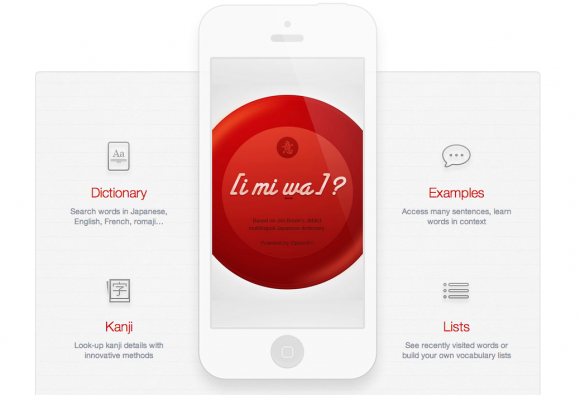
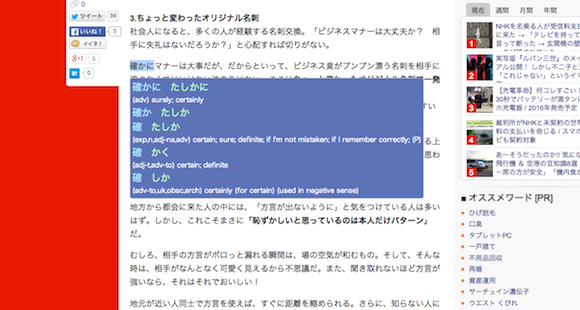
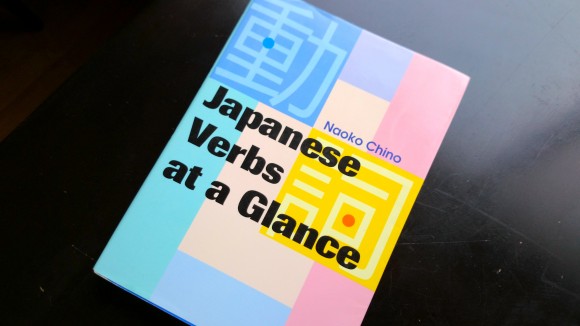
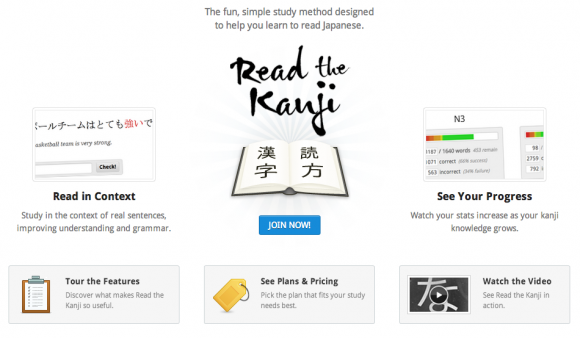
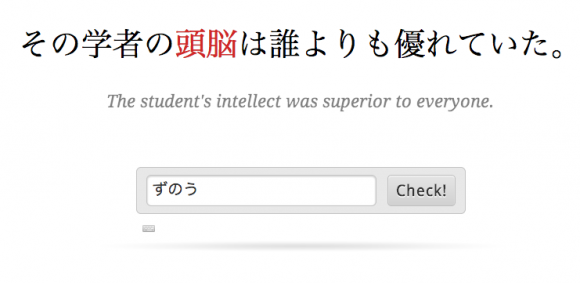
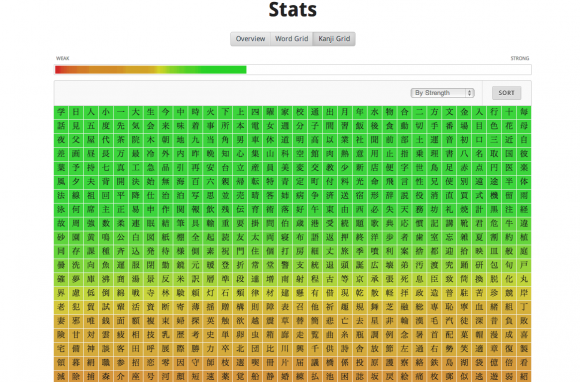

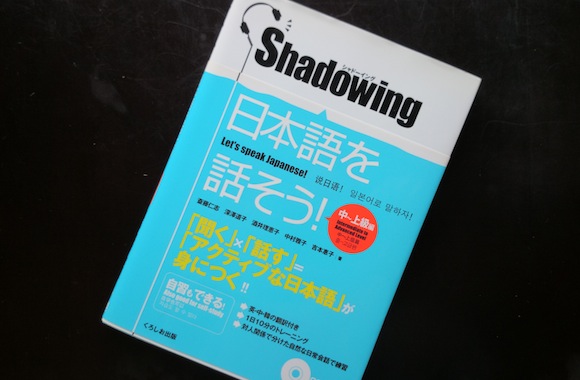
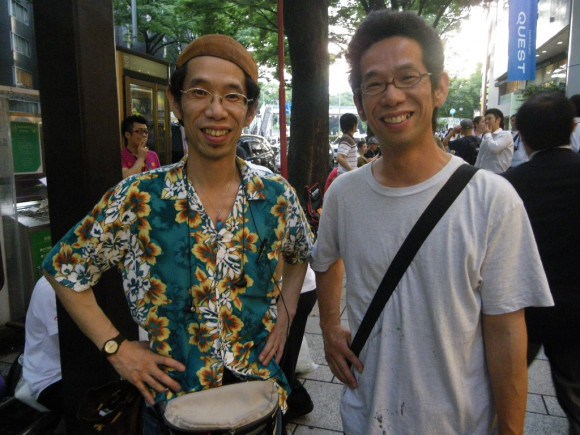
 Tried-and-tested ways to learn Japanese while having fun!
Tried-and-tested ways to learn Japanese while having fun! RocketNews24’s six top tips for learning Japanese
RocketNews24’s six top tips for learning Japanese W.T.F. Japan: Top 5 myths about learning Japanese【Weird Top Five】
W.T.F. Japan: Top 5 myths about learning Japanese【Weird Top Five】 Struggling with Japanese? Let Tako lend you a hand…or five
Struggling with Japanese? Let Tako lend you a hand…or five Learning Japanese? All you really need is this one word…
Learning Japanese? All you really need is this one word… Japan may add Japanese language proficiency, lifestyle classes to permanent foreign resident requirements
Japan may add Japanese language proficiency, lifestyle classes to permanent foreign resident requirements Lacquerware supplier to emperor of Japan and Pokémon team up for new tableware
Lacquerware supplier to emperor of Japan and Pokémon team up for new tableware 7-Eleven Japan starts new temporary luggage storage service in over 300 branches
7-Eleven Japan starts new temporary luggage storage service in over 300 branches Drunk cycling can result in an instantly suspended driver’s license in Japan
Drunk cycling can result in an instantly suspended driver’s license in Japan We try a rotating sushi restaurant in New Delhi, are surprised to find no rotating sushi
We try a rotating sushi restaurant in New Delhi, are surprised to find no rotating sushi The best Japanese cosplayers from Day 4 of Winter Comiket 2019【Photos】
The best Japanese cosplayers from Day 4 of Winter Comiket 2019【Photos】 Permanent Sailor Moon stage show theater announced for Tokyo
Permanent Sailor Moon stage show theater announced for Tokyo Large amount of supposed human organs left in Osaka marketplace
Large amount of supposed human organs left in Osaka marketplace One of Japan’s rarest sweets is a sell-out hit that looks and tastes like frost
One of Japan’s rarest sweets is a sell-out hit that looks and tastes like frost We sample blue Drift Ice Curry from the India of the Okhotsk Sea
We sample blue Drift Ice Curry from the India of the Okhotsk Sea Starbucks teams up with 166-year-old Kyoto doll maker for Year of the Horse decorations【Photos】
Starbucks teams up with 166-year-old Kyoto doll maker for Year of the Horse decorations【Photos】 Disillusionment at Tsukiji’s tourist-target prices led us to a great ramen restaurant in Tokyo
Disillusionment at Tsukiji’s tourist-target prices led us to a great ramen restaurant in Tokyo Tokyo’s Tsukiji sushi neighborhood asks tour groups to stay away for the rest of the month
Tokyo’s Tsukiji sushi neighborhood asks tour groups to stay away for the rest of the month Starbucks Japan releases new zodiac chilled cup drink for 2026
Starbucks Japan releases new zodiac chilled cup drink for 2026 Street Fighter Hadouken Churros to be launched and eaten in Tokyo, Okami pudding on offer too
Street Fighter Hadouken Churros to be launched and eaten in Tokyo, Okami pudding on offer too Is this the most relaxing Starbucks in Japan?
Is this the most relaxing Starbucks in Japan? Starbucks on a Shinkansen bullet train platform: 6 tips for using the automated store in Japan
Starbucks on a Shinkansen bullet train platform: 6 tips for using the automated store in Japan Japan’s human washing machines will go on sale to general public, demos to be held in Tokyo
Japan’s human washing machines will go on sale to general public, demos to be held in Tokyo Japanese train company is letting fans buy its actual ticket gates for their homes
Japanese train company is letting fans buy its actual ticket gates for their homes Tokyo considering law requiring more trash cans following litter increase in heavily touristed area
Tokyo considering law requiring more trash cans following litter increase in heavily touristed area Is China’s don’t-go-to-Japan warning affecting tourist crowds in Tokyo’s Asakusa neighborhood?
Is China’s don’t-go-to-Japan warning affecting tourist crowds in Tokyo’s Asakusa neighborhood? Nintendo’s Kirby now delivering orders at Kura Sushi restaurants, but not in Japan
Nintendo’s Kirby now delivering orders at Kura Sushi restaurants, but not in Japan Tokyo event lets you travel back in time, for free, to celebrate 100 years since Showa era start
Tokyo event lets you travel back in time, for free, to celebrate 100 years since Showa era start Survey asks foreign tourists what bothered them in Japan, more than half gave same answer
Survey asks foreign tourists what bothered them in Japan, more than half gave same answer Japan’s deadliest food claims more victims, but why do people keep eating it for New Year’s?
Japan’s deadliest food claims more victims, but why do people keep eating it for New Year’s? We deeply regret going into this tunnel on our walk in the mountains of Japan
We deeply regret going into this tunnel on our walk in the mountains of Japan Studio Ghibli releases Kodama forest spirits from Princess Mononoke to light up your home
Studio Ghibli releases Kodama forest spirits from Princess Mononoke to light up your home Major Japanese hotel chain says reservations via overseas booking sites may not be valid
Major Japanese hotel chain says reservations via overseas booking sites may not be valid Put sesame oil in your coffee? Japanese maker says it’s the best way to start your day【Taste test】
Put sesame oil in your coffee? Japanese maker says it’s the best way to start your day【Taste test】 The top 10 annoying foreign tourist behaviors on trains, as chosen by Japanese people【Survey】
The top 10 annoying foreign tourist behaviors on trains, as chosen by Japanese people【Survey】 No more using real katana for tourism activities, Japan’s National Police Agency says
No more using real katana for tourism activities, Japan’s National Police Agency says Starbucks Japan reveals new sakura drinkware collection, inspired by evening cherry blossoms
Starbucks Japan reveals new sakura drinkware collection, inspired by evening cherry blossoms Learn Japanese kanji with captivating stop-motion videos created by Tokyo animator
Learn Japanese kanji with captivating stop-motion videos created by Tokyo animator What does a kanji with 12 “kuchi” radicals mean? A look at weird, forgotten Japanese characters
What does a kanji with 12 “kuchi” radicals mean? A look at weird, forgotten Japanese characters Why are there different counters for animals and people in Japanese?
Why are there different counters for animals and people in Japanese? Duolingo free language learning app released their first Japanese lessons, so we tested them out!
Duolingo free language learning app released their first Japanese lessons, so we tested them out! Learn Japanese with us and this website of nothing but swimsuit model selfies
Learn Japanese with us and this website of nothing but swimsuit model selfies Why does Japanese writing need three different sets of characters? (Part 1)
Why does Japanese writing need three different sets of characters? (Part 1) Learn kanji with the magical power of poop!
Learn kanji with the magical power of poop! Sumikko Gurashi origin book gets English/Japanese bilingual release, great for language learners
Sumikko Gurashi origin book gets English/Japanese bilingual release, great for language learners Anime-style magic circles summon vocabulary for you in this language-learning app from Japan【Vid】
Anime-style magic circles summon vocabulary for you in this language-learning app from Japan【Vid】 Why does Japanese writing need three different sets of characters? (Part 2)
Why does Japanese writing need three different sets of characters? (Part 2) Put away your textbooks, kids – the key to learning Japanese is Minecraft
Put away your textbooks, kids – the key to learning Japanese is Minecraft English learner’s dictionary you must have, my young Padawan!
English learner’s dictionary you must have, my young Padawan! The Japanese you learn at school vs the Japanese used in Japan【Video】
The Japanese you learn at school vs the Japanese used in Japan【Video】 Learn Japanese through ridiculous manga: Two Piece 【Episode #1】
Learn Japanese through ridiculous manga: Two Piece 【Episode #1】 Four ways Japanese isn’t the hardest language to learn
Four ways Japanese isn’t the hardest language to learn
Leave a Reply